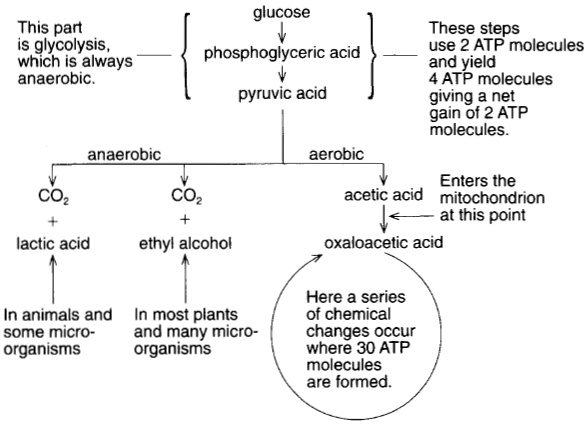The Anaerobic and Aerobic Pathways
Although the events of respiration may be thought of as the reverse of the events of photosynthesis, they are not altogether the same events in the reverse order. The first stage of respiration, called glycolysis, is an anaerobic process of the initial breakdown of sugar. The 6-carbon glucose is broken down into two 3-carbon molecules of pyruvic acid. In order for this to occur, however, the glucose must first be linked to phosphate groups (a process known as phosphorylation). The molecule is then cut in two to make pyruvic acid (see figure 10-7). Glycolysis, then, requires some energy; but it yields slightly more energy than it uses. There is, in fact, an energy gain of two ATP molecules. Following glycolysis, the pathways diverge according to whether the events are anaerobic or aerobic. Anaerobic processes, which can be called fermentation, produce one set of products, whereas aerobic processes produce another. Fermentation such as occurs in yeast cells yields ethyl alcohol; in other types of cells, lactic acid is the product of fermentation. Aerobic processes first make acetic acid. The acetic acid then enters the mitochondria, where a series of cyclic events takes place. These events are summarized in figure 10-7.Aerobic processes are far more efficient in making ATP than are the anaerobic processes. Whereas aerobic breakdown of a mole (gram molecular weight equal to 180 grams) of glucose releases 684,000 calories of heat, anaerobic breakdown of the same amount of glucose releases only 28,000 calories. Thus, 24.1 times more heat is evolved in aerobic respiration than in anaerobic respiration. In fermentation, two ATP molecules are made for each molecule processed.
On the aerobic pathway, the compound formed immediately following pyruvic acid is acetic acid. The acetic acid then enters the mitochondria, where the remaining chemical changes of respiration occur. These changes take a cyclic pattern, with oxaloacetic acid being formed next and, after a total of nine intermediate steps, oxaloacetic acid being formed again. The complete cycle results in the formation of thirty ATP molecules.
 |
| Figure 10-7 The events of respiration. The first steps, collectively called glycolysis, are always anaerobic. The pathways then diverge, going one way if oxygen is available and another way if oxygen is unavailable. On the aerobic pathway, the chemical changes take a cyclic pattern known as the Krebs cycle. |
In 1937 Sir Hans Krebs' uncovered the chemical changes that occur in the # Notes # mitochondria. Although these changes were first collectively described as the citric acid cycle,t hey are now known as the Krebs cycle. Each step in the cycle sees the elimination of one acetic acid molecule and the formation of two carbon dioxide molecules and four pairs of hydrogen atoms. Each of the nine steps in the Krebs cycle requires a specific enzyme, and the enzymes are arranged in sequence for effective exploitation. The Krebs cycle occurs in plants, molds, bacteria, and animals.




